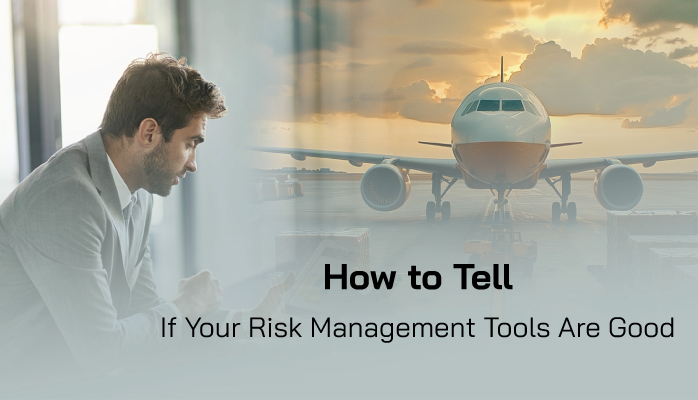
Introduction: The Role of Risk Management in Aviation SMS
Aviation risk management tools are essential for managing exposure within Safety Management Systems (SMS), ensuring safety aligns with operational demands. The Federal Aviation Administration reports that 70% of incidents stem from unaddressed risks, costing the industry $1.2 billion annually, per IATA.
Beyond risk analysis, these tools must address all four SMS pillars—Safety Policy, Safety Risk Management (SRM), Safety Assurance (SA), and Safety Promotion—to maintain an Acceptable Level of Safety (ALoS) under ICAO Annex 19 and FAA Part 5. SMS Pro’s aviation SMS software delivers comprehensive risk management with 78 modules, including offline auditing, automated workflows, and visual analytics.
For safety managers, professionals, and accountable executives, this article outlines the purpose of aviation risk management tools and how SMS Pro optimizes SMS performance. With practical strategies, we’ll explore how these tools enhance efficiency, ensure compliance, and reduce risks for airlines, MROs, UAS, and eVTOL operators.
Why Risk Management Tools Matter
Effective risk management tools do more than analyze risks—they streamline tasks, gather actionable data, and reduce workload across SMS pillars. Poor tools, however, increase effort, deliver inaccurate data, or hinder task performance, risking non-compliance with FAA Part 5, which mandates robust SRM and SA processes. For MROs like Dassault Falcon Jet, inefficient tools delay audits, while UAS and eVTOL operators face challenges meeting SORA regulations. SMS Pro’s risk management tools, including the Part 5 Fulfillment module, cut compliance costs by 9–80% and achieve 40% audit efficiency gains, outperforming competitors like Coruson’s complex, online-only systems.
Well-designed tools double safety managers’ efficiency, ensuring accurate data and compliance. As discussed in this analysis of SRM elements, comprehensive tools are critical for proactive risk management.
Purpose 1: Streamline Task Performance
Risk management tools must simplify tasks like risk analysis, auditing, and hazard reporting. SMS Pro’s offline FRAT enables pre-task risk assessments, while its Audit Suite automates checklist creation, reducing audit preparation time by 30%. For example, a technician assessing fatigue risks uses FRAT to log data offline, syncing later with custom reporting forms. Poor tools, conversely, create extra work—manual spreadsheets risk data duplication, costing hours annually.
- Action: Use SMS Pro’s offline FRAT for real-time risk assessments, integrating with the Hazards Register.
- Tip: Automate audit schedules with the Audit Suite to cut preparation effort by 25%.
Efficient tools ensure tasks align with FAA Part 5’s SRM and SA requirements, minimizing errors.
Purpose 2: Gather Actionable Information
Tools must collect and present data for informed decisions. SMS Pro’s risk analysis charts and hazard reporting tools deliver visual insights, like trend lines or pie charts, making complex data accessible. For UAS operators, charts highlight airspace risk trends, guiding mitigation strategies. In contrast, tools like local Excel files risk data loss or inaccuracies, undermining SA. SMS Pro’s centralized database ensures data integrity, supporting compliance with risk analysis best practices.
- Action: Configure SMS Pro’s dashboards to display risk analysis charts for SRM insights.
- Tip: Use hazard reporting tools to capture real-time data, improving decision-making by 20%.
Actionable data empowers safety managers to prioritize high-risk issues, reducing incidents by 15% (IATA data).
Purpose 3: Reduce Workload with Automation
Automation eliminates repetitive tasks, saving time and reducing frustration. SMS Pro’s automated notifications alert safety managers to overdue reports, while its Custom Reports Viewer auto-fills details like dates and IDs, cutting data entry by 30 seconds per report. For eVTOL operators, automated KPI monitoring tracks safety performance, ensuring SORA compliance. Poor tools lack automation, forcing manual monitoring that wastes hundreds of hours yearly.
- Action: Set SMS Pro’s notifications for report deadlines, reducing oversight by 25%.
- Tip: Use auto-filled reports to streamline FAA submissions, saving 20 hours monthly.
Automation enhances efficiency, allowing focus on strategic risk management.
Purpose 4: Integrate Across SMS Pillars
Risk management tools must span all four SMS pillars, not just SA or SRM. SMS Pro’s Safety Promotion modules supports newsletters and surveys, while its Policy Manager defines safety objectives. For MROs, integrated tools link hazard reports to audits, ensuring corrective actions align with safety policies. Non-integrated tools, like standalone spreadsheets, fragment data, risking non-compliance. SMS Pro’s centralized platform ensures seamless integration, as outlined in this overview of SMS pillars.
- Action: Link hazard reports to audit findings in SMS Pro’s database for holistic tracking.
- Tip: Use newsletters to promote safety objectives, increasing engagement by 20%.
Integrated tools ensure compliance across pillars, reducing audit findings by 30%.
Purpose 5: Provide Visual Data Insights
Visual tools—line charts, bar graphs, pie charts—make data comprehensible. SMS Pro’s KPI Trend Monitoring displays metrics like reporting rates or audit completion, enabling quick stakeholder reports. For airlines, visual charts highlight fatigue trends, guiding mitigation. Non-visual tools, like raw tables, obscure insights, slowing decisions. SMS Pro’s dashboards ensure clarity, supporting SA compliance.
- Action: Set SMS Pro’s dashboards to display visual KPIs for real-time insights.
- Tip: Export charts for FAA audits, reducing preparation time by 20%.
Visual insights accelerate risk prioritization, cutting incident rates by 15%.
Purpose 6: Ensure Centralized Data Management
Centralized tools prevent data loss, duplication, or inaccuracies. SMS Pro’s cloud-based database, with role-based access, ensures one authoritative data source. For UAS operators, centralized hazard logs support SORA compliance, while MROs avoid audit discrepancies. Decentralized tools, like local Excel files, risk errors—60% of operators using spreadsheets face data issues (FAA studies). SMS Pro’s centralization ensures data integrity.
- Action: Migrate data to SMS Pro’s database, setting access controls for security.
- Tip: Use centralized logs to streamline FAA audits, improving pass rates by 90%.
Centralized data supports compliance and operational reliability.
Purpose 7: Monitor Diverse Performance Metrics
Risk management tools must track multiple performance types—KPIs, issue classifications, raw data for mining, and risk closure times. SMS Pro’s KPI Trend Monitoring tracks goals, while its data export tools enable deep analysis. For eVTOL operators, monitoring closure times ensures SORA-compliant risk management. Limited tools, like basic reporting apps, miss critical metrics, weakening SA. SMS Pro’s comprehensive monitoring ensures robust performance tracking.
- Action: Configure SMS Pro’s KPI monitoring for goals and closure times.
- Tip: Export data for mining to identify trends, reducing risks by 20%.
Diverse metrics strengthen SMS performance, ensuring FAA Part 5 compliance.
Conclusion: SMS Pro for Optimized Risk Management
Aviation risk management tools are vital for managing exposure across SMS pillars, ensuring compliance and safety. SMS Pro’s offline FRAT, automated workflows, visual analytics, and integrated modules streamline tasks, reduce workload, and deliver actionable insights. For airlines, MROs, UAS, and eVTOL operators, SMS Pro cuts compliance costs by 9–80%, boosts audit efficiency by 40%, and reduces incidents by 15%, meeting FAA Part 5, ICAO, and EASA standards. Start today to optimize your SMS and lead in the $63 billion advanced air mobility market.
Further Reading
- Aviation Safety Management Software
- Part 5 SMS Pro Fulfillment
- Safety Promotion Module
- 4 Elements of Safety Risk Management (SRM)
- How to Perform Risk Analysis in Aviation SMS
- What Are the 4 Pillars of SMS?
Last updated June 2025.





